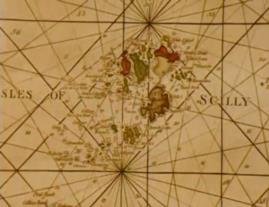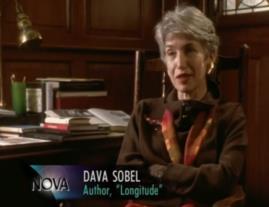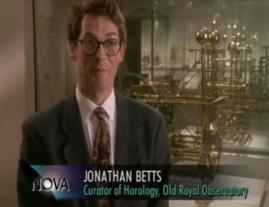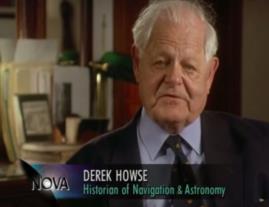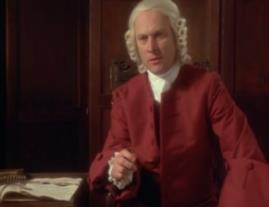
NavList:
A Community Devoted to the Preservation and Practice of Celestial Navigation and Other Methods of Traditional Wayfinding
From: Frank Reed
Date: 2015 Mar 13, 14:53 -0700
As I noted a few days ago, it's been twenty years since Dava Sobel's little book "Longitude" revolutionized the world of popular science publishing and brought the story of celestial navigation and John Harrison and the "discovery" of longitude to an audience at least a thousand times larger than in any earlier time. Like all things, it was an imperfect creation, but it spawned a number of related productions in other media including an episode of the science documentary television series "Nova" which aired in October of 1998. A link was recently posted on our Facebook celestial navigation group, and I've discovered that there are some watchable, good-quality copies available online. There's a good one here: https://www.youtube.com/watch?v=NENPdT4LASw.
The documentary tells the basic story of the search for longitude. It's a "Harrison-friendly" perspective, of course. The production values are excellent, and as long as you know there are a few errors, I recommend it. It's beautifully narrated by Richard Dreyfus.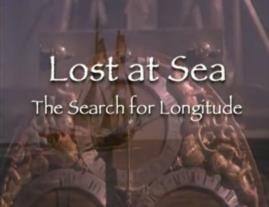
Like nearly all twentieth century accounts of the Longitude Act and the "prize", Sobel's "Longitude" over-emphasizes the significance of longitude in the destruction of Cloudesley Shovell's fleet on the rocks near the Isles of Scilly in 1707. Uncertainty in longitude was without a doubt a contributing factor, probably the principal factor, in the disaster, but in the era the cause of the disaster was not at all clear. The natural philosophers or the "scientific community" as we would call them today, among them a reluctant Isaac Newton, who advocated the Longitude Act used the Scilly disaster to build public support for their cause which was scientific navigation and specifically a scientific solution to the longitude problem. The historical truth, such as we can see it, is not quite the straight-line story found in 20th century accounts, nor is it the inverted revisionist claim that the Shovell disaster was unrelated to longitude occasionally encountered after the publication of Sobel's book. This documentary avoids both extremes.
One nice thing about a video is that you get a chance to attach faces and voices to the names that we know from the historiography of the story of longitude. Naturally, Dava Sobel is interviewed in this documentary. I met her at a little presentation she gave here in Rhode Island last year. Despite the intervening 17 years, she looks and sounds very much the same today. Sobel made a real fortune from this book, and it gave her the publishing credibility to pursue and write about other topics in the history of science that have interested her. She also has become highly skilled on the publishing publicity circuit. Some of you may recall I posted her autograph in my copy of the "Illustrated Longitude" a few minutes after she signed it last summer. I don't think I mentioned at the time how quickly she came up with a flattering inscription and how careful her calligraphy was. She's had years of practice!
Will Andrewes was a collaborator of Sobel's at this time in the 1990s. He was the principal organizer of the conference at Harvard which convinced Sobel to write "Longitude". Andrewes also contributed most of the extensive additional text that makes the "Illustrated Longitude" (amazon link) such a treat.
Jonathan Betts was "Curator of Horology" at Greenwich Observatory in 1998. I'm not sure of his official position today, but he is still probably the world's top expert on Harrison's timepieces. He's the author of another little book, simply titled "Harrison", which offers more technical details on Harrison's chronometers than you'll find in Sobel's "Longitude". I recommend it (amazon link).
Derek Howse was the author of the only full biography of Nevil Maskelyne. Maskelyne was the Astronomer Royal and the creator of the original "Nautical Almanac" which was specifically and almost exclusively designed for observing and working lunars for longitude. Although Maskelyne is explicitly labeled a "villain" in Sobel's "Longitude", this is too harsh. It credits him with too much will. Maskelyne was no villain unless being foolish is its own flavor of villainy (and maybe it is). As Howse, who is friendly to his subject, notes Maskelyne was "pompous" and a "bit of a prig". He was hard-working, meticulous to a fault, but ultimately a narrow-minded bureacrat. Maskelyne was a man without vision, and he was a man who famously backed the wrong horse in the longitude debate and earned the hatred of John Harrison and, even more so, his son William Harrison.
Suzane Debarbat's contribution in the documentary provides an example of the continuation of one of the great myths about lunars and lunar distances. While Maskelyne over-emphasized them and should have devoted far more resources to helping Harrison and the other clockmakers, the conception that lunars were impossibly difficult is a simple misunderstanding. Debarbat here says, "The method of lunar distances was based on very long calculations. I have read that it needs of four hours of calculations after one observation to obtain the longitude! Four hours of calculations!" It's amazing. She actually says "I have read." Not, I have experimented, not even, I have discovered. Clearly she was being asked to speak outside her area of expertise in this segment. The "four hours" of calculation was the time required to calculate a longitude by lunar in the period before 1767 (before anyone considered them genuinely practical). This was before the Nautical Almanac was available with its pre-computed tables of lunar distances. After 1767, the time to work a lunar immediately dropped to about half an hour. By 1800, the time required was only about 15 minutes. And there is ample primary source evidence for this in the form of worked lunars in actual logbooks from the period.
To paint Harrison himself, this documentary relies on actors. And they show him as a noble figure. This is not unreasonable but like most driven creative artisans, he was also a bit nuts. It's a shame that there is no suggestion in the documentary that some of Harrison's reactions were probably paranoid. In our century, he probably would have been prescribed more frequent vacations at the beach.
The documentary closes with some footage of one of the USAF's GPS control centers and brings us back to that other twentieth anniversary. NavList itself owes its origins as a community to both of these threads: twenty years of "Longitude" and twenty years of GPS.
Frank Reed
Conanicut Island USA
